British history back to life with a V-Twin streetfighter
Nothing succeeds like success, and English entrepreneur Paul Sleeman’s achievement of selling all 24 examples of the limited edition Hesketh 24 V-twin streetfighter costing GBP 35,000 each (including 20% VAT) with which he brought the aristocratic British historic marque back to the marketplace in 2014, has now resulted in the debut of a follow up model, the more retro-themed ‘60s-style Hesketh Sonnet café racer. In doing so, it confirms the restoration of a brand to the marketplace whose CV is so improbable that it’s worthy of a Hollywood screenplay – as indeed transpired in the recent hit Formula 1 movie Rush [see history].
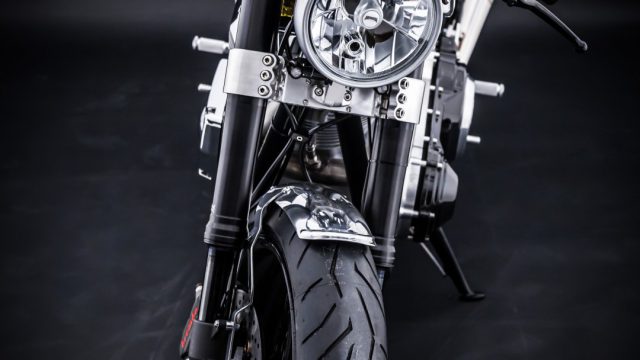
Powered by an uprated version of the same US-built S&S air/oil-cooled ohv pushrod 56.25º V-twin X-Wedge motor adorning the 24, the Sonnet is a continuation of its earlier sister bike’s Anglo-American theme, gone large. For this modern two-wheeled version of the legendary classic-era AC Cobra sportscar utilises the 124ci (2,163cc) version of the Wisconsin-made triple-camshaft dry-sump engine family, compared to the 24’s hardly wimpish 117ci (1,917cc) powerplant. Classic car fans will readily compare this to the later 428ci Cobra versus its 289ci predecessor, with which Texan Carroll Shelby first had the idea of combining American brawn with British corner-carving capability by slotting an American Ford V8 motor into a British AC Ace chassis, and that’s the path Hesketh owner Sleeman has followed in creating the Sonnet.
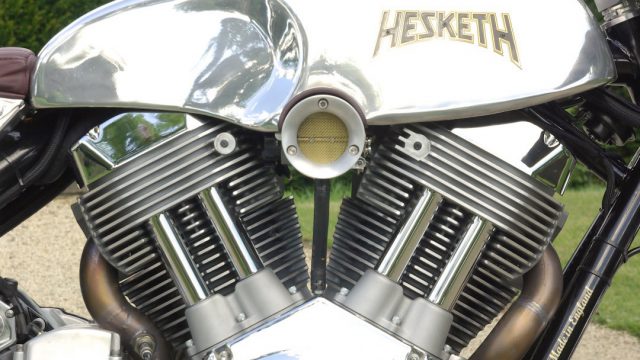
Yet doing so has ended up providing Hesketh customers with more bike for less money, with the new model representing a conscious modern reinterpretation of a Swinging ‘60s-era British café racer retailing at a reduced GBP 25,000 price tag, partly thanks to the economies of scale in purchasing components that Sleeman says Hesketh is now able to achieve, and by changing those suppliers for others less costly. But coupled with a sportier trio of camshafts with more lift and dwell developed by S&S for Hesketh, the Sonnet’s ‘square’ 4.40 x 4.40 in. (111.76 x 111.76 mm) engine dimensions help deliver 145 bhp at 6,000 rpm, a useful 21 bhp more than the born-again Hesketh brand’s debut model, with a corresponding jump upwards in the bike’s massive tractor-like torque. The Sonnet now produces a hefty 210 Nm/155 ft-lb at 3,000 rpm, up from the 24’s not exactly feeble 196 Nm/145 ft-lb at the same revs, making the provision of at least two of the six speeds in the new model’s Rivera Primo gearbox replacing the more expensive Baker transmission in the 24, quite superfluous. The Sonnet also features a lighter, quieter toothed belt primary drive and oil-bath clutch hidden behind their carbon fibre cover, compared to the 24’s duplex chain primary.

Paul Sleeman, 52, is a mechanical design engineer whose London-based company Tullman Design has developed and manufactures the best-selling Diesel Key, a patented invention which makes it impossible to mistakenly fill a diesel-engined vehicle’s fuel tank with petrol. The generous profits generated by this and other Tullman Design products have allowed British bike enthusiast and ‘70s Norton Commando owner Sleeman to satisfy his ambition to become a motorcycle manufacturer. He duly acquired the rights to the Hesketh marque in a deal signed with Lord Alexander Hesketh in May 2010, and since then has been working to relaunch the brand with a range of V-twin motorcycles.
“It was only natural that people had their suspicions when we restarted Hesketh,” says Sleeman. “There’s been lots of small high-end motorcycle companies come and go over the past 20 years, and while we weren’t exactly criticised for making the 24, there was a slightly downbeat reaction to it – as if people were thinking, how can they possibly survive? Well, we’ve not only survived, but we’re prospering, too. We’ve found our two dozen customers for the 24 all over the world, with the majority in the UK, but we’ve sent bikes to Germany, Spain, Australia and Russia, too, and we’ve had rave reviews from all of them. It seems the Hesketh 24 completely lived up to our customers’ expectations, which is the most important thing you can ever do when you’re asking someone to part with a large sum of money on a promise as much as anything else. Now we have to show everybody that Hesketh is not a one-trick pony, and that’s what the Sonnet represents. In building this bike we’re showing the world we aren’t going anywhere for now but up, and we’ve got other exciting, quite different things in the pipeline.”
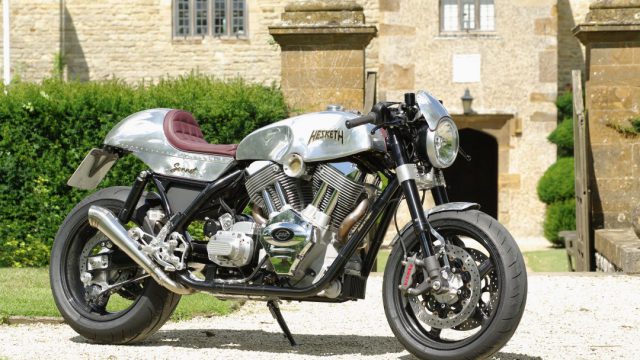
Indeed so. Sleeman has targeted selling 100 examples of the Sonnet in 2017 – a volume which he says will generate the funding to produce the next landmark model along the Hesketh comeback trail. That’s the V4 streetfighter he’s already started work on developing, based on the American-made liquid-cooled 1650cc ohv engine built by Motus in Birmingham, Alabama to power its MST sports touring models that have been in production for the past couple of years, to widespread acclaim. Sleeman has inked an agreement with Motus for a supply of engines, which he plans to use as the basis of what he terms “a big thuggish roadburner of a bike that will dominate the highway in terms of real world performance.” Sounds like fun – and more importantly, this will further set Hesketh apart from the competition. “We see any Hesketh motorcycle as above all representing engineering excellence,” says Paul Sleeman. “The original V1000 was born from a Formula 1 race-winning car, and for 1981 it was an extremely advanced piece of two-wheeled engineering. It was the first British streetbike to employ double overhead camshafts together with four valves per cylinder. Ducati were then still only making two-valve air-cooled 750s, Guzzis and Harleys only had pushrods, and here we had a Made in England 1000cc eight-valve V-twin motorcycle with the Hesketh coat of arms on the tank. OK, there’s been a 30-year gap in the middle, but we want our customers to be proud that their Hesketh is still technically excellent, and quite unlike anything else available elsewhere.”
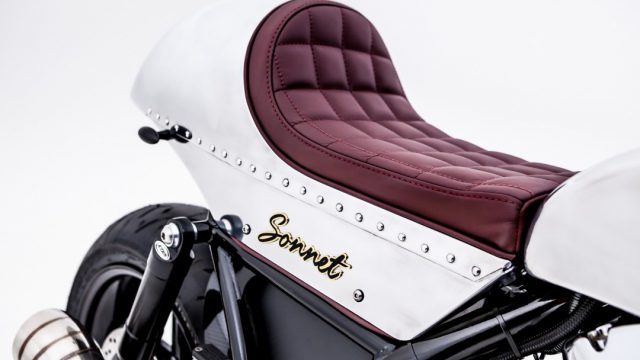
But that’s in the future, and the Sonnet is here and now, a more affordable member of the Anglo-American hotrod horde than the 24, but with added allure and genuine presence when you see it in the metal. That’s because Sleeman and his R&D team have swung the styling needle firmly back in time towards the Swinging Sixties, in concocting a more potent, more muscular and simply more modern take both visually and dynamically on the café racer era. One look at the Sonnet tells you this pays authentic lip service to the Triton/Tribsa/Norvil concept – an impression confirmed when you throw a leg over its low 760mm/30in high seat, and reach a l-o-n-g way forward over the polished alloy fuel tank to the Sonnet’s clipon handlebars.
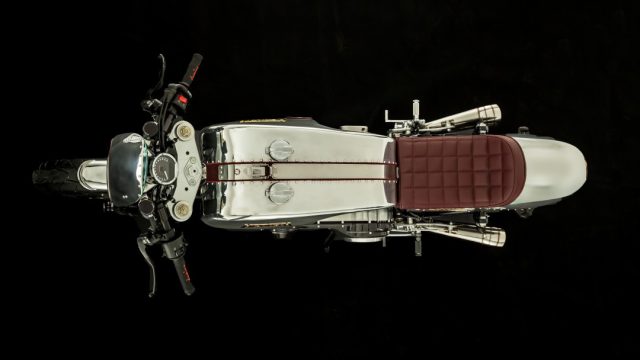
These are mounted beneath the Harris Performance milled-from-solid adjustable upper tripleclamp in which the fully-adjustable 50mm K-Tech KTR-2 upside down fork replacing the Öhlins on the 24 is carried at a 25º rake, with 96mm of trail. But while the riding stance thus delivered is totally authentic – that word again – it’s not very comfortable for, er, more mature riders, who are likely to comprise the majority of Sonnet customers even at its lower price tag versus the 24. That’s compounded by the rearset footrests being precisely that – they’re pretty far back, so that you end up in a semi-forward inclined stance that also puts more weight on your wrists and shoulders. This at least helps load up the front wheel with your body weight for extra grip in turns, though it can get tiring in the process. What Sleeman needs to do here is to offer his clients the choice of a set of raised swans neck ‘bars which will deliver a more upright riding position – though the first thing to do is to redesign the solo seat so that it narrows behind the fuel tank. It’s much too wide there at the moment, which is not only painful but also prevents you moving around easily on the bike in turns. It’ll be an easy fix, but Sleeman needs to pay some attention to getting the ergos right on the Sonnet.
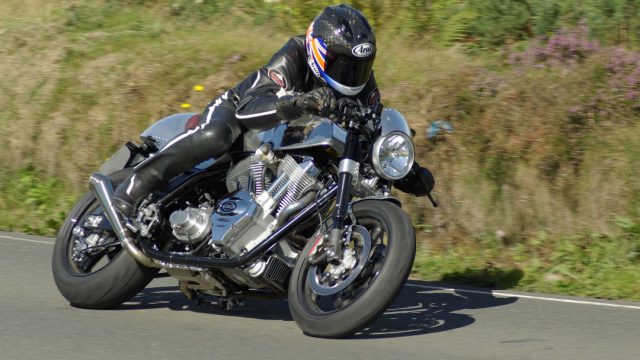
That hand-beaten fuel tank’s left hand section in fact comprises the oil tank for the dry-sump S&S motor, complete with a neat dipstick that becomes accessible when you flip up the Monza filler cap, with the remaining real estate comprising the 13-litre fuel tank with an extension under the seat. That’s a little on the small side for such a big engine, even if the US-made two litre-plus V-twin motor employs a single injector per cylinder, and just one 52.4mm throttle body which doesn’t however stick out unduly, so I never started fouling it with my right knee. I actually had a double dip at riding the Sonnet, first on the Northamptonshire country lanes leading from Silverstone to Sulgrave Manor, the manor house owned by George Washington’s ancestors which is legally allowed to fly the Stars & Stripes alongside the Union Jack. Anglo-American – geddit?! With just five miles showing on the Sonnet’s lonely-looking Koso speedo when I first rode it, the bike needed loosening up before I could form an opinion on it. So with that done, a couple of weeks later I met up again with Paul Sleeman and his Hesketh team headed by development engineer Iain Miles for a day’s ride in the Isle of Man. With no speed limits outside towns and villages, this gave a great opportunity to mark the Sonnet’s report card as a high performance hotrod.

Which is what it surely is, in spite of still being way overgeared for my IoM ride. That’s because the Sonnet is the first modern Hesketh to employ a belt primary drive on which Hesketh’s R&D team have guessed wrong on the gearing – it needs the equivalent of 3T-4T more on the back wheel than at present. Still, thanks to the bigger S&S motor’s massive torque peaking at just 3,000 rpm, halfway to redline, acceleration is genuinely mind-blowing. Revs are almost irrelevant on the S&S motor – just thumb the starter button (no key, just a remote electronic sender unit you tuck into your jeans), relish the groundshaking presence with which it announces that it’s fired up and ready for action as it settles to a lazy idle, then grab a big handful of the Rivera transmission’s less stiff clutch to engage bottom gear. That lighter clutch action makes riding the Sonnet in city traffic less tiring on your left hand than on the 24, and the change action is now slicker, though it still pays to use the clutch for upward shifts in the bottom three gears to avoid jerking the drivetrain.
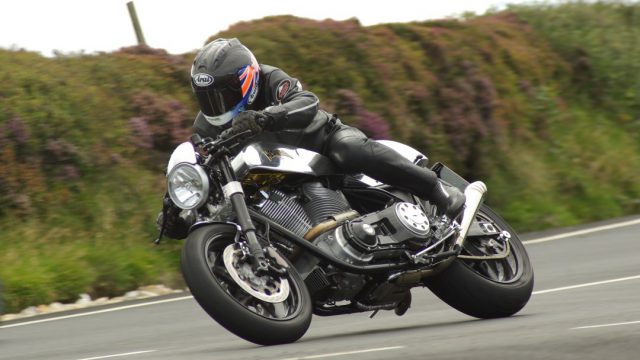
The S&S X-Wedge motor continues to be the most sophisticated-seeming American aftermarket big twin engine I’ve yet ridden, with dynamic qualities on a par with anything produced by Harley or Indian. It’s devoid of the rattles and shakes of most other such engines, with a pleasantly potent-sounding muscular roar emanating from the twin upswept exhausts either side of the bike, with the same lumpy offbeat lilt as a Cobra’s Ford V8 lump. In spite of the fact that S&S disdains fitting a counterbalancer to iron out any vibes, it’s also very smooth by air-cooled American V-twin standards, pulling cleanly off idle thanks to the huge amount of torque on tap at almost any revs – the only tingles you’re aware of come through the handlebars once you really get it revving. By American V-twin standards, it’s pretty refined in terms of operation, practically civilised – well, until you have the chance to exploit the humongous reserves of torque. Then it becomes seriously bad as well as heaps of fun, with awe-inspiring grunt out of turns coupled with what may seem a surprising amount of competence in hustling through them.
The clutch barely needs to be troubled accelerating out of even the tightest turn from little more than walking pace, though you’re best off keeping the revs dialled up a little higher, again to avoid any hint of transmission snatch. But there’s acres of torque from there all the way to what transpires in the curious absence of a tacho on a purported café racer to be the 6,000 rpm revlimiter. But there’s no earthly point in revving the X-Wedge anywhere near that high. Instead, surf that so-strong torque curve and it takes very little time before you see the 100mph mark showing on the black-faced speedo, thanks to those incredible reserves of grunt which makes two of the six ratios in the Rivera gearbox completely superfluous. Still, you can’t resist blipping the throttle when changing gear, just to make music via that meaty-sounding exhaust, which issues a gratifying pop on the overrun after you shut off.
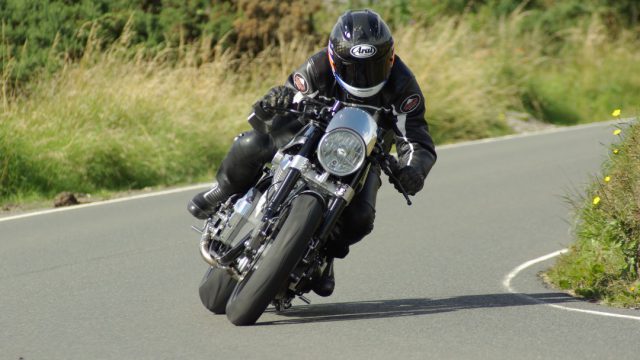
But the Sonnet isn’t just a point-and-squirt device, for it’s a pretty capable corner carver, and its Avon 3D Ultra Sport tyres really help you to build confidence, whether putting your faith in the 120/70 front to carry turn speed through fast sweepers, or delivering all that meaty torque to the ground via the fat 190/55 rear, which grips well when you light the fuse cranked over out of tighter turns. It was the first time I’d ridden with these new Avon triple-compound tyres, and I found them impressive in harnessing the Hesketh’s massive muscle. Equally satisfactory was the K-Tech suspension fitted to the Sonnet to replace the 24’s much dearer Öhlins hardware – the first time the British race suspension specialists whose products dominate BSB grids in most classes, have ever provided OE products for a street model. I’ll admit to looking slightly askance at the absence of the Öhlins, which Paul Sleeman admits was caused by his desire to cut costs – but that was before I rode the Sonnet, and discovered the K-Tech equipment’s outstanding ride quality especially over bumps, with the fully-adjustable KTR-2 upside down fork’s really excellent front end compliance delivering heaps of confidence in attacking corners, although damping at both ends is a little softer by comparison with the Swedish suspension on the 24.
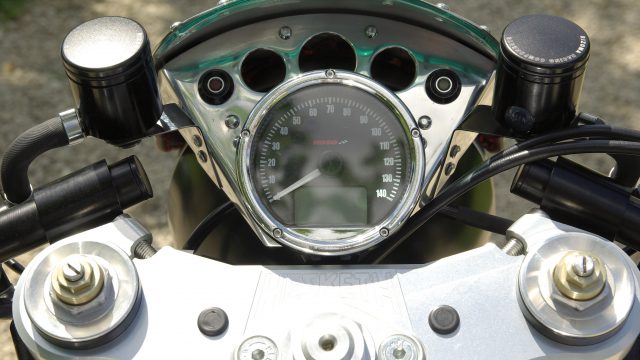
However, that could be because the Öhlins shocks on that were quite stiffly sprung, presumably in order to avoid the S&S motor’s huge torque compressing the rear end when you get on the gas exiting a turn, and thus delivering substantial understeer. The Sonnet does suffer slightly from that, especially accelerating hard cranked over in the lower gears – but the fact that the twin nitrogen-charged springless K-Tech Bullit shocks are completely non-adjustable meant that I couldn’t even crank up the spring preload to try to resolve this. Possibly a pair of longer shocks might be a fix, to lift up the rear end and throw more weight on to the front Avon, even though ground clearance is already pretty good, with just the sidestand on the left grounding out occasionally as an early warning sign that you’ve reached the limit – no dramas, though.
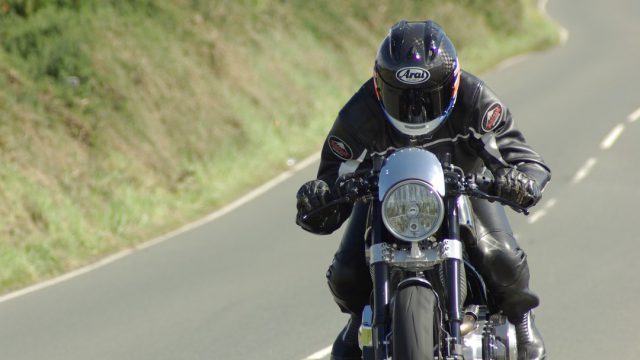
Still, you do feel very much in control of the new Hesketh, whose handling is almost intuitive in spite of being such a heavy package scaling 235kg dry, and with such a long 1560mm/61in wheelbase. For while it’s definitely a very individual riding package thanks to the stretched-out stance, as confidence grows the harder you can ride it. In spite of the long wheelbase it steers well, too, thanks mainly to feeling so well balanced – there isn’t as much leverage from the clipon handlebars as on the 24’s much wider one-piece ‘bar, but that’s not a problem because the geometry feels right. Lowering the cee-of-gee by positioning part of the fuel load down low helps improve manoeuvrability, so that while the steering feels heavy at low speed, it becomes sharper the faster you go, and the Sonnet changes direction well, without undue rider effort in spite of its undeniable bulk. That’s partly thanks to the reduced gyroscopic weight of the front BST carbon wheel, which besides being sun-glinting eye candy that lifts your spirits as you walk towards the bike ready to hop aboard, also helps sharpen the steering as well as improving suspension compliance via reduced unsprung weight. I’m glad Paul Sleeman’s cost-cutting exercise didn’t extend to ditching the South African-made round black featherlight gold ingots…
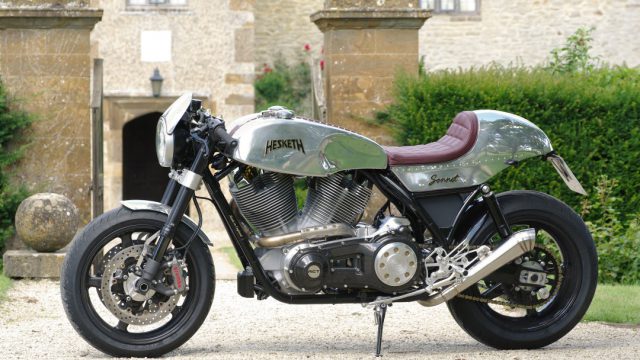
Yet however improbably he’s saved money in fitting Brembo brakes to the Sonnet to replace the 24’s highly effective but also far more expensive Beringers. and not just any Brembos, either, but top of the line radial four-piston Monoblock calipers gripping a pair of floating 320mm discs up front, with the same rear caliper and a 250mm disc. The result is that the Sonnet stops brilliantly from high speed thanks to the great bite delivered so controllably by these brakes, with zero stability issues thanks to the long wheelbase. The K-Tech fork is still stiffly enough sprung that the substantial ensuing weight transfer doesn’t collapse them, and unlike on the 24 both times I rode it, just stroking the front brake lever to lose a little speed in turns doesn’t get the Sonnet sitting up to try to head for the hedges. Sleeman and Co. have obviously massaged the steering geometry very effectively to fix this, given that both bikes share the same essential frame design.
Paul Sleeman and his Hesketh R&D team have succeeded in producing something very distinctive and worthwhile in the new Sonnet, a rorty, raw-edged and totally invigorating combination of American V-twin musclebike performance with British styling flair and handling capability. The new Hesketh delivers a completely unique blend of Anglo-American performance that nobody else offers on two wheels right now.
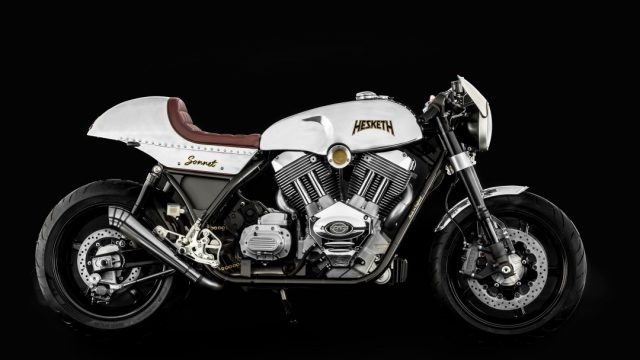

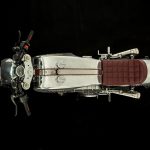
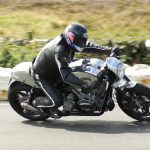
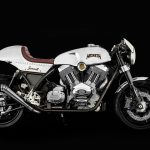
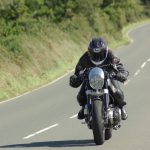


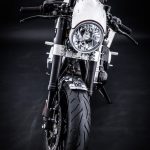
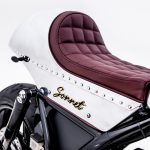
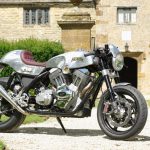
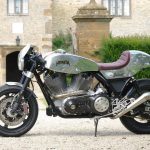
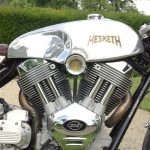
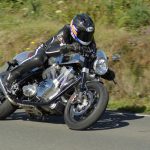
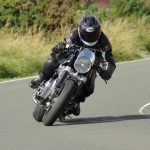
A fantastic looking bike, I would love to test ride one. I have owned several Hesketh V1000s and Vampires both great bikes superb for touring. At present I own a Hesketh 24 which is a superb bike, the build quality is exceptional, the only slight fault I could say is the very small tiny speedo reading (it is where you would normally see the odo reading) obviously in the USA they do not have as many speed traps as here in the UK. These Hesketh bikes should have sold in their thousands!